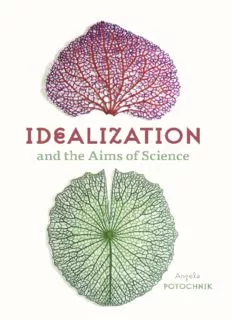
Idealization and the Aims of Science PDF
Preview Idealization and the Aims of Science
IdealizationandtheAimsofScience Idealization and the Aims of Science angela potochnik TheUniversityofChicagoPress ChicagoandLondon TheUniversityofChicagoPress,Chicago60637 TheUniversityofChicagoPress,Ltd.,London ©2017byTheUniversityofChicago Allrightsreserved.Nopartofthisbookmaybeusedorreproducedinanymanner whatsoeverwithoutwrittenpermission,exceptinthecaseofbriefquotationsin criticalarticlesandreviews.Formoreinformation,contacttheUniversityofChicago Press,1427E.60thSt.,Chicago,IL60637. Published2017 PrintedintheUnitedStatesofAmerica 26252423222120191817 12345 isbn-13:978-0-226-50705-7(cloth) isbn-13:978-0-226-50719-4(e-book) doi:10.7208/chicago/9780226507194.001.0001 LibraryofCongressCataloging-in-PublicationData Names:Potochnik,Angela,author. Title:Idealizationandtheaimsofscience/AngelaPotochnik. Description:Chicago:TheUniversityofChicagoPress,2017.| Includesbibliographicalreferencesandindex. Identifiers:lccn2017028476|isbn9780226507057(cloth:alk.paper)| isbn9780226507194(e-book) Subjects:lcsh:Science—Philosophy.|Idealism. Classification:lccq175.p881552017|ddc501—dc23 lcrecordavailableathttps://lccn.loc.gov/2017028476 ∞Thispapermeetstherequirementsofansi/nisoz39.48-1992(Permanence ofPaper). ForMabelandAmelia, thebookendsofthisbook Contents Preface ix 1 Introduction:DoingScienceinaComplexWorld 1 1.1 SciencebyHumans 2 1.2 ScienceinaComplexWorld 11 1.3 ThePayoff:IdealizationsandManyAims 18 2 ComplexCausalityandSimplifiedRepresentation 23 2.1 CausalPatternsintheFaceofComplexity 24 2.1.1 CausalPatterns 24 2.1.2 CausalComplexity 35 2.2 SimplificationbyIdealization 41 2.2.1 ReasonstoIdealize 42 2.2.2 Idealizations’RepresentationalRole 50 2.2.3 RampantandUncheckedIdealization 57 3 TheDiversityofScientificProjects 62 3.1 BroadPatterns:ModelingCooperation 63 3.2 ASpecificPhenomenon:VariationinHumanAggression 70 3.3 PredictionsandIdealizationsinthePhysicalSciences 80 3.4 SurveyingtheDiversity 88 4 ScienceIsn’taftertheTruth 90 4.1 TheAimsofScience 91 4.1.1 UnderstandingasScience’sEpistemicAim 93 4.1.2 SeparatePursuitofScience’sAims 104 4.2 Understanding,Truth,andKnowledge 112 4.2.1 TheNatureofScientificUnderstanding 112 4.2.2 TheRoleofTruthandScientificKnowledge 117 5 CausalPatternExplanations 122 5.1 Explanation,Communication,andUnderstanding 123 5.2 AnAccountofScientificExplanation 134 5.2.1 TheScopeofCausalPatterns 135 5.2.2 TheCrucialRoleoftheAudience 145 5.2.3 AdequateExplanations 153 6 LevelsandFieldsofScience 161 6.1 LevelsinPhilosophyandScience 162 6.2 GoingwithoutLevels 170 6.2.1 AgainstHierarchy 170 6.2.2 PrizingApartFormsofStratification 176 6.3 TheFieldsofScienceandHowTheyRelate 185 7 ScientificPluralismandItsLimits 198 7.1 TheEntrenchmentofSocialValues 199 7.2 HowScienceDoesn’tInformMetaphysics 206 7.3 ScientificProgress 213 Acknowledgments 223 ListofFigures 225 ListofTables 227 Notes 229 References 235 Index 247 Preface Physicistssometimesassumethatsurfacesarefrictionlessplanes.Biologists sometimes assume that populations of organisms are infinite in size. And economists sometimes assume that humans are perfectly rational agents. None of these things is true; they are all idealizations. Idealizations are assumptionsmadewithoutregardforwhethertheyaretrueandoftenwith fullknowledgethattheyarefalse.Idealizationsofallkindspervadescience, andit’s uncommon forscientists totrytoreplacethemwithmoreaccurate assumptions. On the face of it, this is a puzzle. Why do scientists deliber- atelymaintainfalsehoodsintheirtheoriesandmodels?Whatdoidealizations contributetoscience? Inthisbook,Imotivateastrongviewofidealizations’centralitytoscience, andIreconsidertheaimsofscienceinlightofthatcentrality.Ontheaccount Idevelop,sciencedoesnotpursuetruthdirectlybutinsteadaimstosupport humancognitiveandpracticalends.Thoseareprojectstowhichidealizations candirectlycontributeinanumberofways. The first three chapters are used to develop my account of idealization’s central role in science. In Chapter 1, I discuss how science is shaped by its humanpractitionersandbytheworld’scomplexity.Together,thesetwoideas inspireaviewofscienceasthesearchforcausalpatterns,asearchthatinvari- ably relies heavily on idealizations. Idealizations contribute to science in a variety ofways,including byplayingapositiverepresentational role.These ideasaredevelopedinChapter2.InChapter3,Idetailafewcasestudiesthat demonstratetheubiquityofidealizationinscience,aswellasthewiderange ofpurposesitserves. The last four chapters explore the implications of this account of ideal- izationforcentralphilosophicaldebatesabouttheaimsofscience.Chapter4
Description: